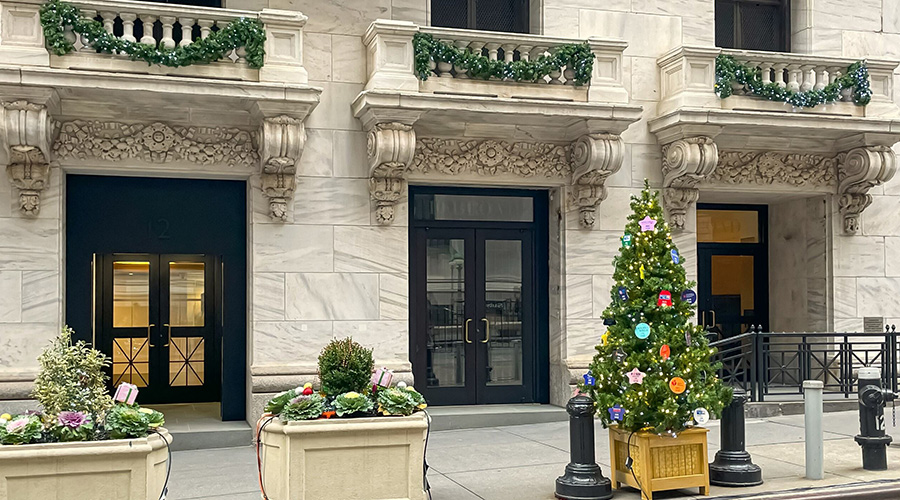Door Hardware Performance Hinges on Both Product And Installation
Although discussions of security or power reliability might capture more attention these days, the fact remains that something as simple as door hardware can have immense effects on a building. When door hardware doesn’t function properly — frequently because a component has been neglected — it often causes damage to more than just the affected component. It can lead to security breaches, compromised occupant safety and the potential for tremendous energy loss.
Door hardware seldom fails prematurely because of a defect in the product. More than likely, failure can be traced to faulty installation or improper door framing. Perfectly good hardware will not last as long as it should in an opening built with inferior construction techniques.
For new construction, facility executives should ensure that the installation is done well. Mike Tierney, standards coordinator for the Builders Hardware Manufacturer Association, says that if installation is appropriate to the site and use, many potential problems are immediately mitigated.
“It is critical that the door and frame are plumb,” he says. “And it needs to be well supported. Often that’s the biggest problem, because if the frame slips, gaps begin to appear.”
Mark Fortun, vice president of the Door Council of the American Architectural Manufacturers Association, echoes Tierney’s advice.
“One of the most important things to do is make sure the builder put the door in correctly, with the frame in very secure and straight,” he says. “If the hinges are not in a straight line, they will work the door panel, causing eventual cracking at the hinge attachment area, or they will work loose the screws that secure the door to the frame.”
Fortun says that if the gap at the strike plate is too close, the curve of the strike will not engage, making the door hard to close.
“This will cause unnecessary stress on the latching mechanism,” he says.
And when frames are not properly backed with shims or filled behind with mortar, the frame can flex.
“Someone can easily pop a latched door by flexing the frame open,” Fortun says. “The wider opening can cause the latch to disengage without any trace of forced entry.”
Tierney recalls a multiunit housing complex for the elderly with one exterior doorway that was supposed to latch. But it wasn’t secured, so residents could leave or enter the facility through the doorway at any time, day or night.
“They were using a vertical rod exit device on the door,” he says. “On the top, the header to the doorway wasn’t reinforced. And on the bottom, the carpeting and threshold strike had been pulled out. Everyone thought it was the hardware’s fault, but it was there and functioning perfectly.”
Selecting What’s Needed
Fortun recommends selecting 4-inch hinges for most commercial use applications. Ensuring that a doorway also uses the correct number of screws — and specifying the appropriate thread for metal door screws — is vital. Wood door specs are no less crucial.
“Every entry door with wood framing is supposed to have at least one long screw installed through each hinge that penetrates into the framing stud,” Fortun says. “Very seldom do builders take the time to do this.”
Tierney says that specifications depend upon the organization and environment.
“Schools have the unique issue of increased vandalism and horseplay,” he says. “Therefore it’s important to start with hardware that’s the proper grade.”
He advises facility executives choose at least Grade II hardware for institutional and commercial settings. Grade I spec is preferable.
“Anything that’s not graded won’t have the necessary strength,” he says.
And for high-use doors, Fortun recommends alleviating potential damage to door hardware by choosing doors that have a window in them.
“Even a small window can help prevent collisions, and the resulting flaring of tempers that is sometimes taken out on the door,” he says.
Maintenance Concerns
Once the door is installed, facility executives should be mindful about following regular maintenance schedules.
“Consider the manufacturer’s instructions,” Tierney says. “There is certain lubrication that might be specified and, often, lubrication makes all the difference in the world in how hardware operates.”
Most manufacturers will specify lubricating hardware on an annual or semi-annual basis, according to Tierney. He also recommends that whenever regular maintenance is performed on doors, technicians also follow up with lubrication.
Fortun recommends a little touch-up with graphite lubrication in the hinges and latch mechanism to help ensure that doors close fully rather than just closing against the latch. At the same time, maintenance staff should check that hinge screws are snug against the hinge.
“Protruding screw heads puts stress on the hinge and frame, as they interfere whenever the door is close,” he says. “This condition causes the other hinges to take up the load of the door.”
Choosing vandal-resistant hardware can also lessen future maintenance requirements. Facility executives in high-abuse environments like schools, hospitals, and prisons, often have to replace hinges, latches and jambs, and worry about the vandalism and security concerns aggravated by improperly performing door hardware.
Facility executives can minimize abuse to both closers and door frames by specifying closers that use relief valves and oil-bypass ports. Many manufacturers are making hardware available with tamper-resistant fastener kits. If no such option is available, purchasing tamper-proof screws can alleviate future vandalism.
Keep in mind that inventories in any organization can be reduced by choosing one size of closer; similarly, specifying universal openers, which can be mounted for left- or right-hand openings, further reduces inventory requirements.
Maintenance should also include checking the exit lights, door knobs, tread plates or sills, and ease of opening. Checking these items not only helps reduce everyday maintenance concerns, but also ensures accessibility requirements are met and that code compliance is achieved.
Up to Code
When doors do not latch or fail to close completely, their ability to withstand fire is compromised. Likewise, doors that fail to open with standard opening force limit egress in the event of fire. Because of such concerns, it is imperative to both facilities and manufacturers that durability is maximized while failure rates are minimized.
Failing to perform routine hardware maintenance — if neglected long enough — can also cause a facility to fail increasingly stringent code requirements.
Portions of the National Fire Protection Association (NFPA) Standard 80 specify that fire doors must pass an annual inspection; the code spells out nearly a dozen requirements fire doors must meet. Additionally, the NFPA’s Life Safety Code is currently undergoing revision that will add more specific egress requirements than the current version has.
“Fire doors must close fully with no assistance,” Fortun says.
NFPA also requires that doors are secured, aligned and not damaged. Year to year there should be no changes to door clearances and no modifications be made to the door.
Remember also that many doors on facilities go totally unused — until they are needed as an emergency egress route. For such doors, the ability to open is paramount.
Improper door fit, maladjusted closer action, and misaligned latches can all cause a door to fail fire and life safety codes.
“Reverse fire doors must open easily,” Fortun says. “Doors that bind may lead to the false impression that they are locked.”
Doors that stick can cause their own maintenance problems for facility executives. When doors are hard to open, they often get shouldered or kicked, resulting in damage to the door panel and premature wear on hinges, sills and strikes.
NFPA requirements aren’t the only standards manufacturers are paying attention to. For example, one of the tests required to gain UL listing includes an oil combustibility test. To meet the requirements of this test, companies have to keep a closer’s hydraulic oil from burning when on the “cool” side of the doorway.
Manufacturers have also made it easier to combine code compliance with reduced maintenance requirements. For example, one company recently replaced the plastic cover on its closer unit with a metal cover. The improved design not only helps the company meet fire standards, but also provides a more durable deterrent against vandalism of the closer.
Making the Right Choices
Choosing hardware that has been rigorously tested is one simple way that facility executives can know they’re choosing durable components. Although some in-house manufacturer tests are impressive — such as the 300-pound “hang test” one company forces closer unit arms to endure — Tierney also advocates choosing components that undergo a battery of independent tests.
“Compare certified products, because they go through some fairly stringent testing,” he says. “We generally put the products of various manufacturers through one or two million cycles as part of the testing.”
The testing performed is according to Builders Hardware Manufacturer Association standards and doesn’t allow for additional lubrication during the test process.
“These products are usually made to be neglected,” he says, explaining the lack of lubrication.
Tierney recommends working with a good distributor and an architectural consultant. “It gets complicated picking the right functions,” he says. “Work with a knowledgeable specifier who can help choose or at least provide good recommendations.”
Fortun concludes with a refrain that’s familiar to many facility executives: “Remember that a few extra dollars up front to buy quality relates to greater savings down the road.”
Loren Snyder, a contributing editor for Building Operating Management, is a writer who specializes in facility issues. He was formerly managing editor of Building Operating Management.
Related Topics:











